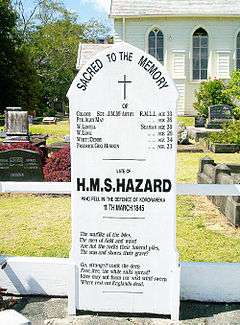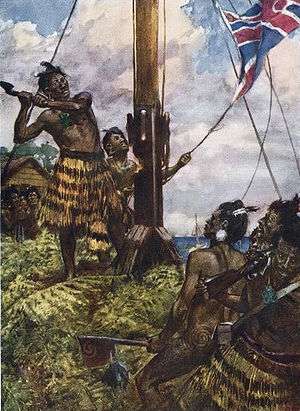Battle of Kororāreka
| ||||||||||||||||||||||||||||||
The Battle of Kororāreka, or the Burning of Kororāreka, on 11 March 1845, was an engagement of the Flagstaff War in New Zealand. Following the establishment of British control of the islands, war broke out with the native population which resulted in the fall of the present day city of Russell to Māori warriors.[2]
Background
Although he had been the first to sign the Treaty of Waitangi in February 1840, Nga Puhi chief Hōne Heke became increasingly unhappy with the outcome. He objected to the relocation of the capital to Auckland and changes to custom tariffs that caused a serious loss of revenue to the Ngāpuhi.[3]
In July 1844, Heke and a group of warriors entered the town, and the Pakaraka chief Te Haratua cut down the flagstaff. Six months later on 10 January 1845 the flagstaff was cut down a second time - this time by Heke. A new and stronger flagstaff sheathed in iron was erected later that month and guard post built around it - but the next morning the flagstaff was felled for the third time.
Governor FitzRoy sent over to New South Wales for reinforcements. A block-house was built around around the base, a guard of 20 soldiers was placed in this, and a fourth flagstaff erected.[4]
Battle
On 11 March 1845 Hōne Heke and his men, along with Te Ruki Kawiti and his followers together attacked the town.
British forces were outnumbered. The sloop-of-war HMS Hazard landed a party to aid the 96th Regiment of British Army infantry under Lieutenant Colonel William Hulme. In all there were about 140 soldiers, sailors and marines. The American sloop USS St. Louis, under Commodore Foxhall A. Parker, was also present and her crew assisted in evacuating the British citizens.[5]
Heavy skirmishing lasted for a while until a large explosion destroyed all of the defender's reserve ammunition. The explosion also set a building on fire which spread. After that the British had no choice but to retreat to the harbour, taking with them the civilian population. HMS Hazard then bombarded the advancing Māori forces.
Eleven British defenders were killed and at least eight others were wounded in the attack. Six men from the Hazard who died in the action are remembered by a marker in Russell; the town was mostly destroyed during the fighting.[5]

Memorial
The last two verses of the poem England's Dead by Felicia Hemans was inscribed on the marker in memory of the six men from the Hazard who died in the action:[1][6]
England's Dead
The Warlike of the Isles
The Men of Field & Wave
Are not the rocks their funeral piles
The Seas & Shore their grave?Go Stranger, track the Deep,
Where rest not Englands dead.
Free, free the white sails spread,
Wave may not foam, nor wild wind beat,
See also
References
- 1 2 King, Marie (1992). A Most Noble Anchorage: A Story of Russell and the Bay of Islands. Northland Historical Publications Society.
- ↑ "Battle of Kororareka". Russell Museum. Archived from the original on 24 July 2011. Retrieved 23 June 2011.
- ↑ Kawiti, Tawai (October 1956). "Hekes War in the North". No. 16 Ao Hou, Te / The New World, National Library of New Zealand. p. 46. Retrieved 10 Oct 2012.
- ↑ New Zealand Electronic Text Centre THE NEW ZEALAND WARS: A HISTORY OF THE MAORI CAMPAIGNS AND THE PIONEERING PERIOD: VOLUME I (1845–64). Chapter 4: The fall of Korarareka.
- 1 2 Colledge, J. J.; Ben Warlow (2006). Ships of the Royal Navy: The Complete Record of all Fighting Ships of the Royal Navy. London, England: Chatham University. p. 159. ISBN 978-1-86176-281-8. OCLC 67375475.
- ↑ Morris, Edward Ellis (1890). Cassell's picturesque Australasia, Volume 4. Cassell & Company. p. 125.
